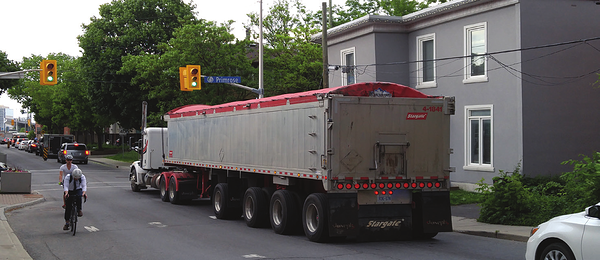
by Martha Musgrove
A continual river of traffic flows up and down Booth Street in Centretown, dividing an otherwise vibrant neighbourhood. How a narrow street lined with houses became a major thoroughfare for commuters, tour buses and heavy trucks is a story of short-sightedness, neglect and inertia.
Early Development Plans
In the 1970s, when plans first emerged to clear and then redevelop LeBreton Flats, the City of Ottawa included a proposal in its Official Plan to extend Bronson Avenue north to the Hull sector of Gatineau. In preparation for this overpass crossing the Ottawa River, Preston Street–an arterial route–was turned into a T-junction at Albert Street and the north end of Rochester Street was closed off completely. By default, Booth Street became the sole route for north- and south-bound interprovincial traffic crossing Chaudière Bridge, presumably until the Bronson extension could be built.
By the turn of the 21st century, city planners and politicians recognized that the Bronson extension would be an eyesore, marring the prime real estate value of LeBreton Flats and Victoria Island, and the proposal was removed from Ottawa’s Official Plan. Sadly, no plan B for handling interprovincial car and heavy vehicle traffic was implemented.
As a result, Booth Street became a de facto replacement for the Bronson extension, although the street was clearly inadequate for the task even 20 years ago. Tailbacks—long queues of idling vehicles—became a daily occurrence. The situation has only grown worse since.
Chaudière Bridge
Strictly speaking, heavy vehicle traffic is allowed on Booth only north of Albert Street but the no-truck rule is often and regularly flouted.
Why the National Capital Commission decided the two-lane Chaudière Bridge was appropriate to serve as only one of two designated truck crossings of the Ottawa River is puzzling. The bridge is a venerable structure. Its steel portion was constructed in 1919 and some of its supporting arches date back to 1828, so the Chaudière crossing long predates the widespread use of cars and trucks.
In 2004 the bridge was closed to repair deteriorating arches. This past spring, high water levels forced another multi-week closure. Does it really make sense to have transport trailers—some of them double length—crossing here?
Residents and Traffic Woes
For residents, Booth Street creates ongoing problems. We can live with the noise, dirt, rumbling bass from car speakers, and long delays to enter or leave our own driveways. Other impacts are far more serious.
Traffic congestion on the street forces cyclists to take to the sidewalks, potentially endangering pedestrians. When high snowbanks block sightlines, entering Booth from a driveway or side street is risky. Constant heavy vehicle traffic causes vibrations that undermine the structural integrity of the heritage houses lining the street. Neighbours, separated by an impassable river of traffic, find community-building difficult.
Most concerning, however, is a study, undertaken in 2016 by Public Health Ontario and the Institute for Clinical Evaluative Sciences, that found residents living within 50 metres of a major road have a significantly higher likelihood of developing cognitive impairment than those living more than 300 metres from heavy traffic. As Booth is so narrow, when vehicles are stuck in traffic, their exhaust systems spew air pollutants and stir up particulate matter less than 30 metres from the windows of our houses. The daily six-hour commuter congestion period, channelling volumes associated with a major road, could well be creating health risks for those living along the street.
Finding Solutions
City staff have suggested we report illicit heavy vehicle use on Booth to the police: we do but it is completely futile. The Ottawa Police Service online reporting system is geared to specific crimes–not systemic traffic problems. The complaint form is cumbersome to use and intrusive, as complainants must indicate their age and gender when submitting it.
Police are rarely seen along the street and the community has not received a report on actions taken, if any.
The more congested Booth becomes, the more traffic leaks to side streets as commuters try to avoid bottlenecks, and our traffic problems spread to other streets even less able to handle heavy traffic.
As climate change accelerates flooding and closures of the Chaudière bridge will increase. Neither residents nor commuters are happy, and the situation isn’t going to improve itself.
Dalhousie Community Association
The Traffic Committee of the Dalhousie Community Association is encouraging the City to revisit its Transportation Master Plan (TMP) as part of the current Official Plan review. We are also developing a series of principles that we will encourage the City to adopt. As a starting point, we cannot do better than to remind the City of two objectives already in the 2013 TMP: “[m]inimize the community impacts of truck and automobile traffic, and minimize air pollution from transportation.”
We urge the City to take interprovincial traffic into consideration when developing a TMP. The 2013 plan made only passing reference to Gatineau traffic.Fuelled by cheaper housing and affordable day care, the City of Gatineau continues to grow and much of that population will work in Ottawa.
Booth Street residents had a brief respite this summer while the Chaudière crossing was closed due to floods, repair and construction on the Flats.
Commuters were not so lucky. Repairs, upgrading and new construction on other bridges resulted in epic congestion at interprovincial crossings.
The delays, frustrating as they were, have had benefits: we now have evidence of just how much interprovincial traffic runs through Ottawa-Gatineau each day, and commuters have a good idea of their future journeys to and from work should nothing be done.
Martha Musgrove is a member of the board of the Dalhousie Community Association.
